“Gardening is an instrument of Grace” – May Sarton
The joy of gardening for some people comes from producing life-sustaining vegetables. For others, it is the visual delight of flowers. For many, it is an art form, the creation of living design in nature: color, form, texture and pattern. For me, gardening in Maine has been all of those things, plus a source of healing, of recovering from grief.
When my husband Aubrey and I fell in love with our idyllic island home in mid-coast Maine, there was one serious problem: the lack of a proper open area and sun exposure for a vegetable garden. His experience of growing vegetables as a child in the Green Spring Valley of Maryland produced a lifelong passion for him.
Immediately after we signed the contract in the summer in 2000, Aubrey hired a mid-coast Maine landscaper with heavy equipment to clear and prepare the only flat space that existed on the property. It covered about 900 square feet bordering the outer edge of the grassy septic field between the house and the garage/guesthouse. It was also the only area of a full day’s sunlight. All of the scrubby shrubs and bushes growing there would have to be removed. I knew very little about gardening in Maine and went along with all his decisions.
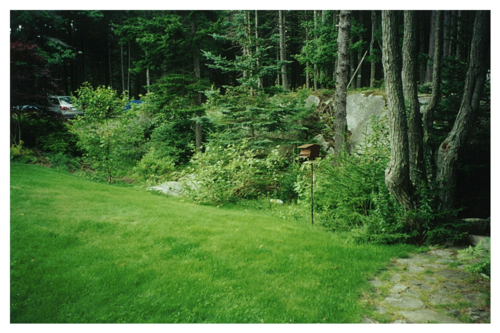
That fall, as truckloads of new sod were brought in, large rounded rocks were carefully placed in a semi-circle to protect the dramatic, tree-sized rhododendron. In the process of removing the shrubs and bushes, massive granite boulders, covered with lichen, were revealed. We had barely noticed them before. The garden area became a stage setting between the edge of the grass and the granite curtain.
Once the new dirt settled in the spring, Aubrey divided the area into sections with a specific planting plan for each one. He had studied Johnny’s Seed Catalog all winter with an eye towards what would grow well in Maine. We were both aware of the differences in the short Maine growing season: the many more hours of sunlight, the cool nights with days—sometimes weeks—of fog and rain. There would be no beefsteak tomatoes or watermelons, both of them beloved staples from his Maryland garden. There were, however, worthy compensations in Maine. Aubrey was particularly excited by the thought of raising English peas and Haricots Verts, something impossible to grow in the heat of Maryland summer.
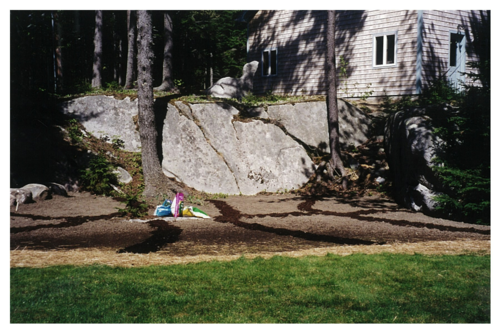
I loved every minute of learning the vegetable gardening basics from Aubrey: the planning, the planting, the maintenance and the harvesting. The proper way to create rows of carrots, beets and green beans is to first tie a string between two stakes at either end of the row. Then plant the seeds by hand under the string. Within a week to ten days we would watch the tiny sprouts pop out of the ground in a more or less straight line. A layer of old newspapers was put between the rows, thinly covered with dirt to keep out the weeds. He made mounds like little islands for the zucchini and yellow crookneck squash seedlings. He planted seed potatoes cut in half with the eye facing upward. As soon as the potato plants blossomed, he showed me how to dig around for the small new potatoes, an adventure akin to searching for underground Easter eggs, careful not to puncture the delicate skin.
During the summer of 2002 when Aubrey was suffering from advanced pulmonary fibrosis, the result of radiation for his lung cancer, he could not perform his usual gardening chores. On many days with a pair of osprey circling overhead and Bear, his beloved Bernese Mountain Dog, nestled next to his chair, he gave me explicit directions for planting and harvesting the vegetables. Watching every sprout magically appear through the dirt was still our joint creative endeavor. The fun was doing it together.
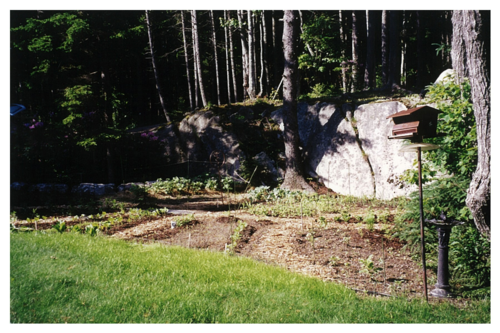
After Aubrey died in late August, I could not bear to plant vegetables without him. The idea of digging new potatoes or picking the young green beans alone would have been a painful reminder of my loss. Still, I wanted to have a garden in the space. I was hooked on the experience, and I knew that he would want me to continue what we had started. I decided to use the vegetable beds for flowers. Something different for a different life.
In the spring of 2004 I began my study of flower gardens I had known and loved through the years. One of my first experiences with flowers had been my grandmother’s garden in Nashville, Tennessee, when I was five years old. I can recall it all from one whiff of the citrus scent of a marigold. I poured over flower catalogs and walked through gardens and nurseries all over the mid-coast area. Before I bought anything, I asked myself specific questions. Which flowers did I love to see growing? What would I want to pick for flower arrangements in my house? What would grow well in Maine with the least amount of maintenance? I chose mostly perennials: delphinium, phlox, bachelor buttons, Shasta daisies, Japanese anemone, astrantia, and a few annuals: zinnias, nasturtiums and marigolds. For the next two summers I struggled with creating a traditional Maine cottage garden to cover the memory of Aubrey’s vegetables.
Three years later when I returned to Maine in the spring, I discovered that I was in a different place in my life. Having followed an abiding dream to pursue my life-long love of writing, I had completed the Master of Fine Arts in Writing Program at Spalding University. I no longer needed the constant care diversion that a cottage garden required. I needed quiet time and a quiet place to write.
In mid-May, before the trees were fully leafed out or any of the perennials were more than a few inches out of the ground, I became aware of the powerful presence of the granite boulders in the back of the garden. In my determination to fill the garden with flowers, as with my determination to stay busy and try to make a life without Aubrey, I had neglected to see the natural, simplistic beauty of the boulders. There was something ancient, enduring, and tranquil about them. Before I planted anything, I needed to honor the rocks. The rocks would not only become the centerpiece of my garden, they would also become a metaphor for my life.
The more I studied the space, the more I believed it was the perfect background for a Japanese garden. I contacted Lee Schneller, a recognized designer of Japanese gardens in Maine. She drew a plan to build a low stonewall to separate the lush grassy septic field from the garden area. She suggested planting mostly hosta and Japanese painted fern and low-growing astilbe behind the wall and at the base of the boulders. A path would wander through the space with flat, irregular stepping-stones. Lamium and creeping thyme would serve as the ground cover. There would be several different textures and shades of green with a few blooming plants to add a white or pale pink accent. The garden would become an organized, meditative place of serenity, rather than the wildness and confusion of a cottage garden.
Slowly over the years, I have added my own touches to Lee’s original design. A large viburnum in the corner near the rhododendron blooms with perky white blossoms all summer long. Creeping Jenny has spread up the far side of the boulders resembling a lime-green waterfall. A dwarf Japanese cut-leaf maple tree holds the center of the garden. A weeping white pine on one end of the pathway forms a sculptural balance with a Kasuga stone lantern on the other. From every angle of the garden, I can turn and see a wondrous view, what the Japanese refer to as “borrowed landscape”: deep pinewoods on one side and the blue expanse of the lower Penobscot Bay reaching all the way to the horizon. Each time I drive in my driveway and see my garden, I have a sense of both continuity and peace.
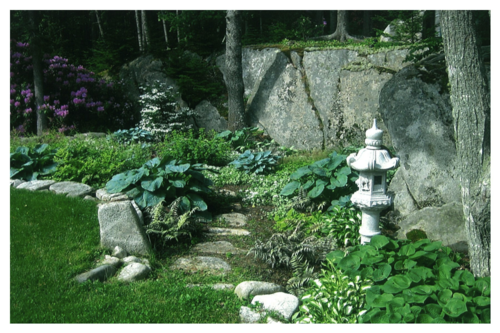
Two summers ago, I asked Steve Lindsay, a Maine sculptor, to carve a rounded stone with Aubrey’s name that would designate a place for him in my garden. I had held a small portion of his ashes with the idea of keeping them somewhere close to the place we originally created together. I had also saved a small wooden box with Bear’s ashes. Two years after Aubrey died, our dear Bear developed a terminal cancer and had to be put down. I buried them together in my Japanese garden beneath the sheltering branches of the blooming viburnum. Through all seasons, there is a small clay statue of St. Francis who stands behind the stone and watches over them.
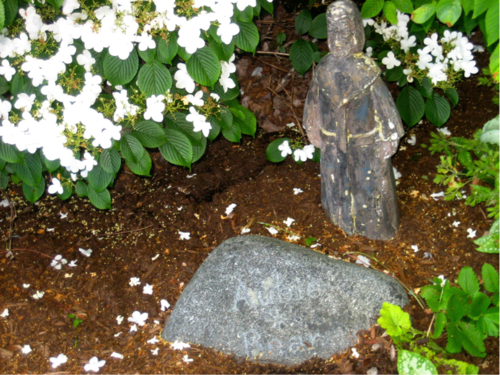
Every summer now I am reminded that my garden holds many of my treasured memories and continues to offer the transformative, regenerative spirit of new life. I have found May Sarton’s statement to be true: the gardening experience, in all its forms, has been an instrument of Grace.
Leave A Comment